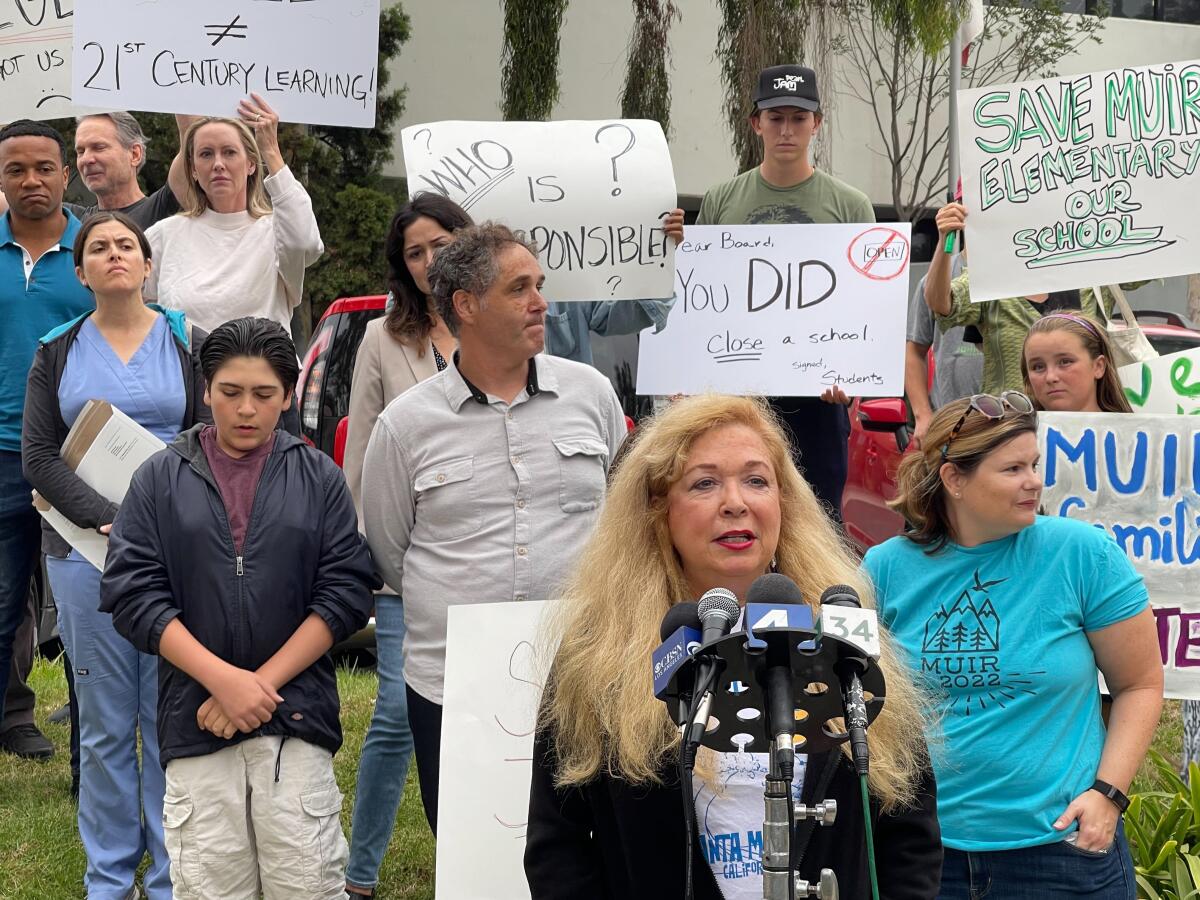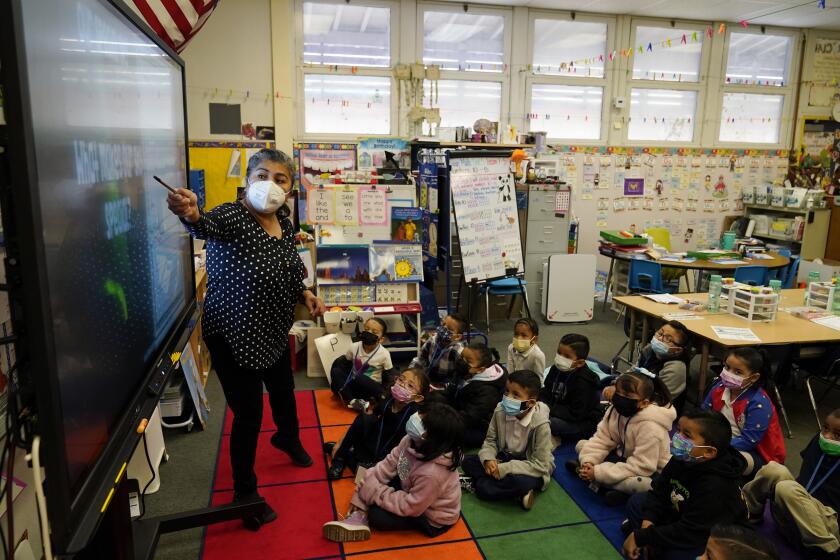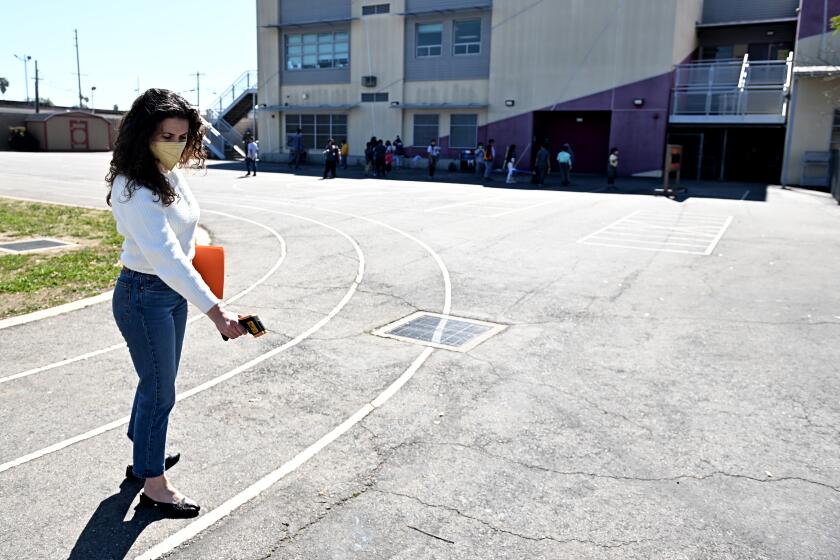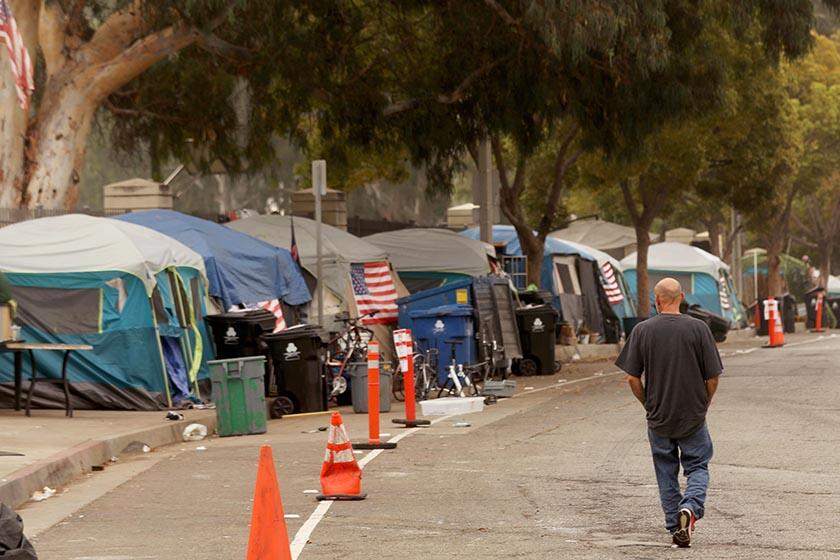Water damage, mold closed a Santa Monica elementary school. Parents say it follows years of neglect

- Share via
For students like Lucky Basseri, Santa Monica’s John Muir Elementary School was a blessing.
Now a freshman at Santa Monica High School, Lucky said his former campus was a place where children from diverse social, ethnic and economic backgrounds learned together and formed lasting friendships.
“It was perhaps the best school I’ve ever been to,” he said. “That school, John Muir, was truly a staple of the … community, and it is very upsetting to see what is happening to it right now as the future hangs in the balance.”
John Muir students were transferred to other schools after water intrusion and mold shut down the campus, which served Santa Monica’s beachside Ocean Park neighborhood, in June. The issues were discovered during an HVAC-installation project in the spring, officials said.
Parents and staff agreed to close the school for two years for renovations, said Gail Pinsker, a Santa Monica-Malibu Unified School District spokesperson.
At a rally Thursday night, community members alleged years of neglect had led to the campus falling into disrepair. Lucky was joined by about two dozen parents and school board candidates who called for transparency from district officials.
No grade suffered more enrollment drop than kindergarten during the pandemic. Proponents say mandatory enrollment is a solution. Newsom disagrees.
In a statement, Pinsker said officials were aware of the rally and described the situation on the campus as “a water intrusion problem, not a mold infestation problem.”
She acknowledged that “some mold was discovered.”
A district report published May 24 listed 11 rooms where inspectors found “apparent water damage in the form of elevated moisture content, discoloration, staining, bubbling, and peeling/cracking.”
Visible mold growth was found in one of the rooms.
“It’s important to note that once moisture is introduced to certain building materials, it generally takes about 24-48 hours for mold to begin growing; therefore, based on these results, the history of moisture intrusion and visual observations, additional ‘hidden’ mold growth is suspected within the impacted wall and ceiling cavities,” the report stated.
The inspection firm recommended further testing to determine the scope of water damage and hidden mold growth, followed by mold remediation performed under Environmental Protection Agency guidelines.
District officials considered keeping the students on campus and performing repairs and remediation by rotating classrooms into temporary bungalows, but the proposal was quickly nixed.
After two meetings with parents, the officials decided to close it down and temporarily move all students to other schools until they could reopen the campus, which also housed the Santa Monica Alternative School House for K-8 students.
Janet McLaughlin, Lucky’s mother, said her son started fainting and developed a persistent cough while attending Muir.
Multiple doctors, including a pediatric cardiologist and a neurologist, were not able to diagnose Lucky. Though she can’t directly point to mold as the culprit, McLaughlin said her son’s symptoms resolved after he left the school.
In a statement Tuesday, Supt. Ben Drati said district officials know the students and families want to return to their close community.
“Again, we wish this relocation had not been necessary,” Drati said. “I know I speak for the entire Board of Education and our district staff in once again expressing how sorry we are for the situation. We very much appreciate the resilience of our students and families.”
Children shouldn’t be forced to learn and play in hot, asphalt-covered, fenced-in campuses, especially in neighborhoods that already lack park space.
Work to repair and improve the campus housing John Muir and Santa Monica Alternative is “moving forward as planned,” he said.
District officials plan to hold meetings beginning in November with a committee of parents and staff from Muir and the alternative school to discuss programs and opportunities once the campus is reopened, Drati said.
The district is also working on hiring bus drivers to transport displaced Muir students from their neighborhood to the Will Rogers Learning Community and Grant Elementary School, he said.
“Unfortunately, we continue to be short five bus drivers and do not currently have the ability to run this route,” Drati said.
The district has offered all students free TAP cards that can be used on Santa Monica’s Big Blue Bus system and is looking into providing fare for parents who want to accompany their children.
Before the beginning of this school year, parents were allowed to tour campuses and choose which they felt would best suit their child, Pinsker said. The majority of the displaced Muir students went to Will Rogers Learning Community, while 25 students went to Grant Elementary.
The adjustment, however, has been difficult on students, said Diana Maruri, the parent of a Muir student.
“They’ve had to adapt to their new friends, new teachers, a new place; it’s different from when the children would get up and walk a few blocks,” Maruri said in Spanish.
The students have to wake up earlier, and their parents have had to upend their schedules to accommodate longer commutes to school, she said. Not all the parents have vehicles.
“There are many children where we don’t know how they’re doing because we haven’t been able to meet with all the parents,” Maruri said.
Her son, a fourth-grader, misses his teachers, his friends and the close-knit community that surrounded his former school, she said.
Miles Warner, a school board candidate, called the situation at the Muir campus “unacceptable.”
The candidate said he sees a disconnect between the district’s statements on a commitment to diversity and equity, and how the Muir elementary campus was treated.
“This was the school that was the most diverse school,” Warner said. “This is how they treated this school. So all of the promises, all of the performative ideas about equity seem to ring hollow when this school shut down due to mismanagement that 100% could have been avoided.”
What do voters think of the CARE Courts for the mentally ill signed into law by Gov. Newsom, and the mandatory kindergarten bill he vetoed?
Parents are asking that the school be rebuilt and that they no longer have to share a campus with Santa Monica Alternative, he said.
“We want a seat at the table moving forward and we do not want to go back to how things were where multiple principals came through every few years,” Warner said. “We want to be treated like all the other schools in the district.”
For the record:
4:54 p.m. Oct. 10, 2022A previous version of this article cited a school board candidate who said John Muir Elementary School is Santa Monica-Malibu Unified School District’s sole Title I school. It was one of five Title I schools in the district, four of which remain open.
Muir was one of the district’s five Title I schools, a U.S. Department of Education designation for schools with high percentages of low-income families that qualify them for additional funding, Pinsker said. Four remain after Muir’s temporary closure: Will Rogers Learning Community, McKinley Elementary School, Edison Language Academy and John Adams Middle School.
“There is no loss of funding from Muir,” the spokesperson said. “The funds follow the students to the new school they attend.”
In a statement to The Times, Jon Kean, a school board member, said the district and board have been very attentive to concerns at the campus.
“While repairs did yield short term positive results, it became clear that the physical problems ran deeper,” Kean said. “The district brought in a nationally recognized consultant to get to the bottom of the problems. Upon reading the subsequent report and the clarity of needs, the district and school board took immediate and decisive action to close the campus and relocate students to other schools and campuses.”
The decision to close the campus and move students was not easy but was the right move, he said.
And officials have been clear in their intent to fix the facility issues permanently and “reinvigorate the campus as a vital neighborhood school,” Kean said.
“There has been and will continue to be clear and open communication and collaboration with families and stakeholders as we proceed on what we expect to be a two-year journey,” he said. “It is a shame that while Muir, SMASH, and other elementary campuses throughout [the district] have accepted this temporary disruption to their school’s routines and have embraced the challenges for the benefit of students, others in the community are sadly using this complicated time to score political points against the school district with students as their pawns.”
For Lucky, the Muir alumnus, the issue boils down to a simple request.
“All I’m asking for right now is to see that school have its future decided in a positive way, where we can keep this community together,” he said.
More to Read
Sign up for Essential California
The most important California stories and recommendations in your inbox every morning.
You may occasionally receive promotional content from the Los Angeles Times.

















